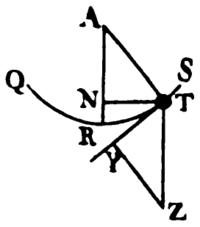leſs) of two oſcillations, will be always as thoſe parts, and therefore will cauſe thoſe parts to be deſcribed together. But bodies which continually deſcribe together parts proportional to the wholes, will deſcribe the wholes together alſo. Q. E. D.

Cor. 1. Hence if the body T (Pl. 20. Fig. 3.) hanging by a rectilinear thread AT from the centre A, deſcribe the circular arc STRQ, and in the mean time be acted on by any force tending downwards with parallel directions, which is to the uniform force of gravity as the arc TR to its ſine TN, the times of the ſeveral oſcillations will be equal. For becauſe TZ, AR are parallel. the triangle ATN, ZTY are ſimilar; and therefore TZ will be to AT as TY to TN; that is, if the uniform force of gravity be expreſſed by the given length AT the force TZ by which the oſcillations become iſochronous, will be to the force of gravity AT; as the arc TR equal to TY is to TN the ſine of that arc.
Cor. 2. And therefore in clocks, if forces were impreſſed by ſome machine upon the pendulum which preſerves the motion, and ſo compounded with the force of gravity, that the whole force tending downwards ſhould be always as a line produced by applying the rectangle under the arc TR and the radius AR to the line TN, all the oſcillations will become iſochronous.
